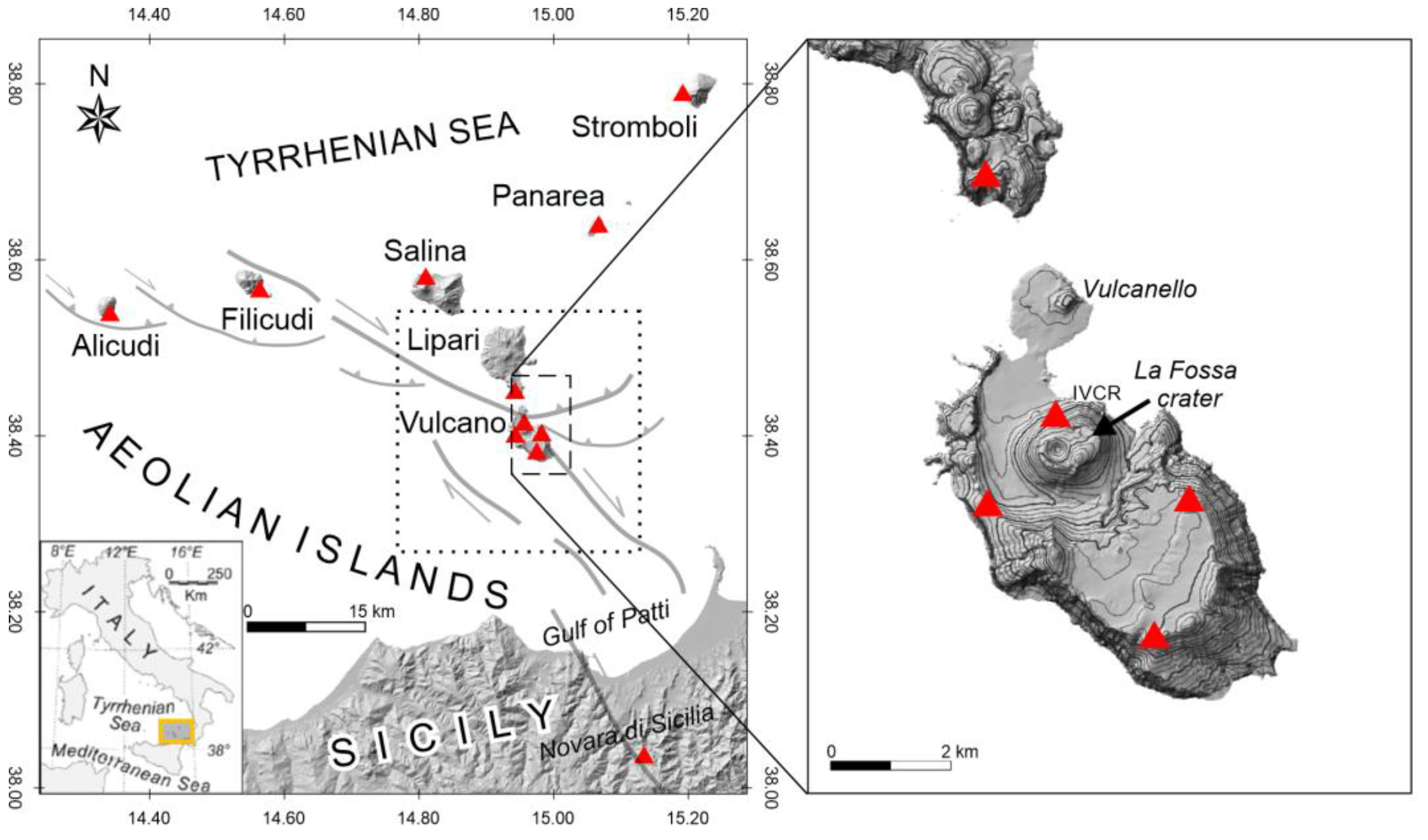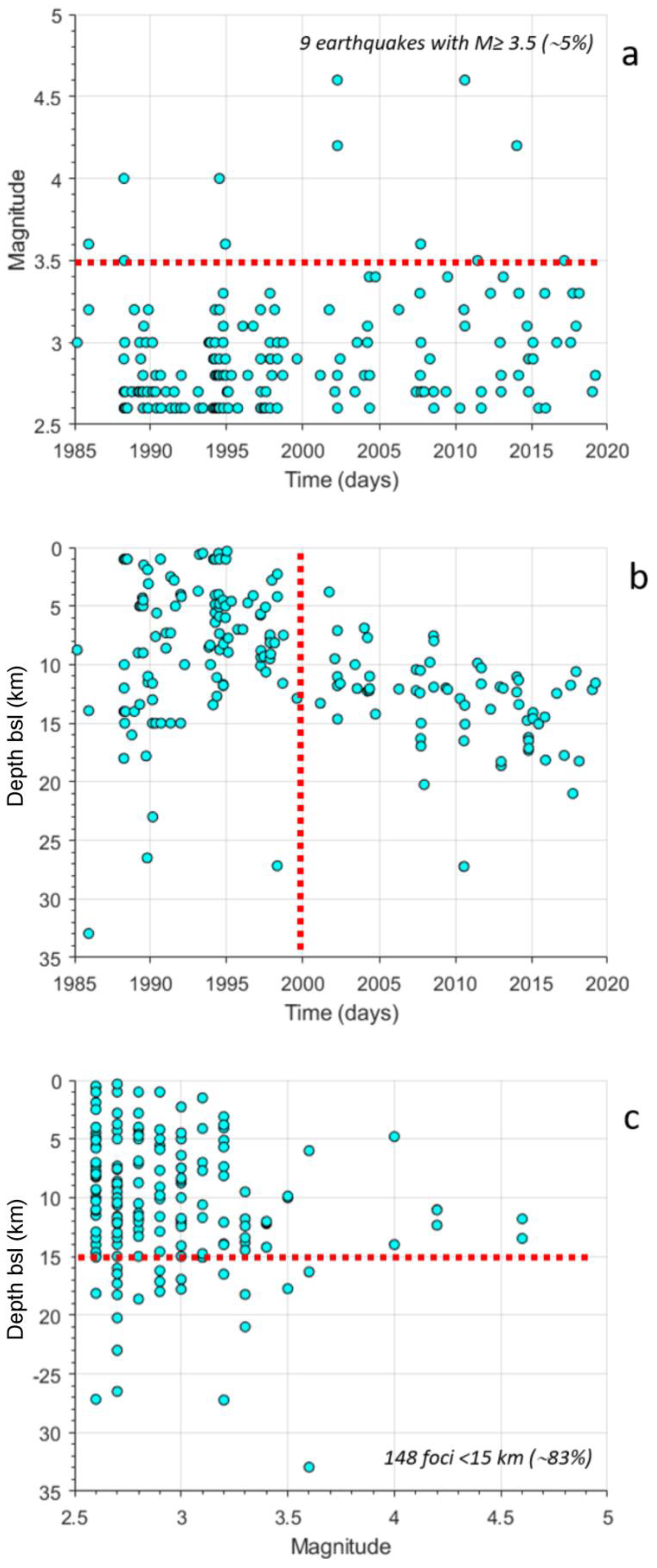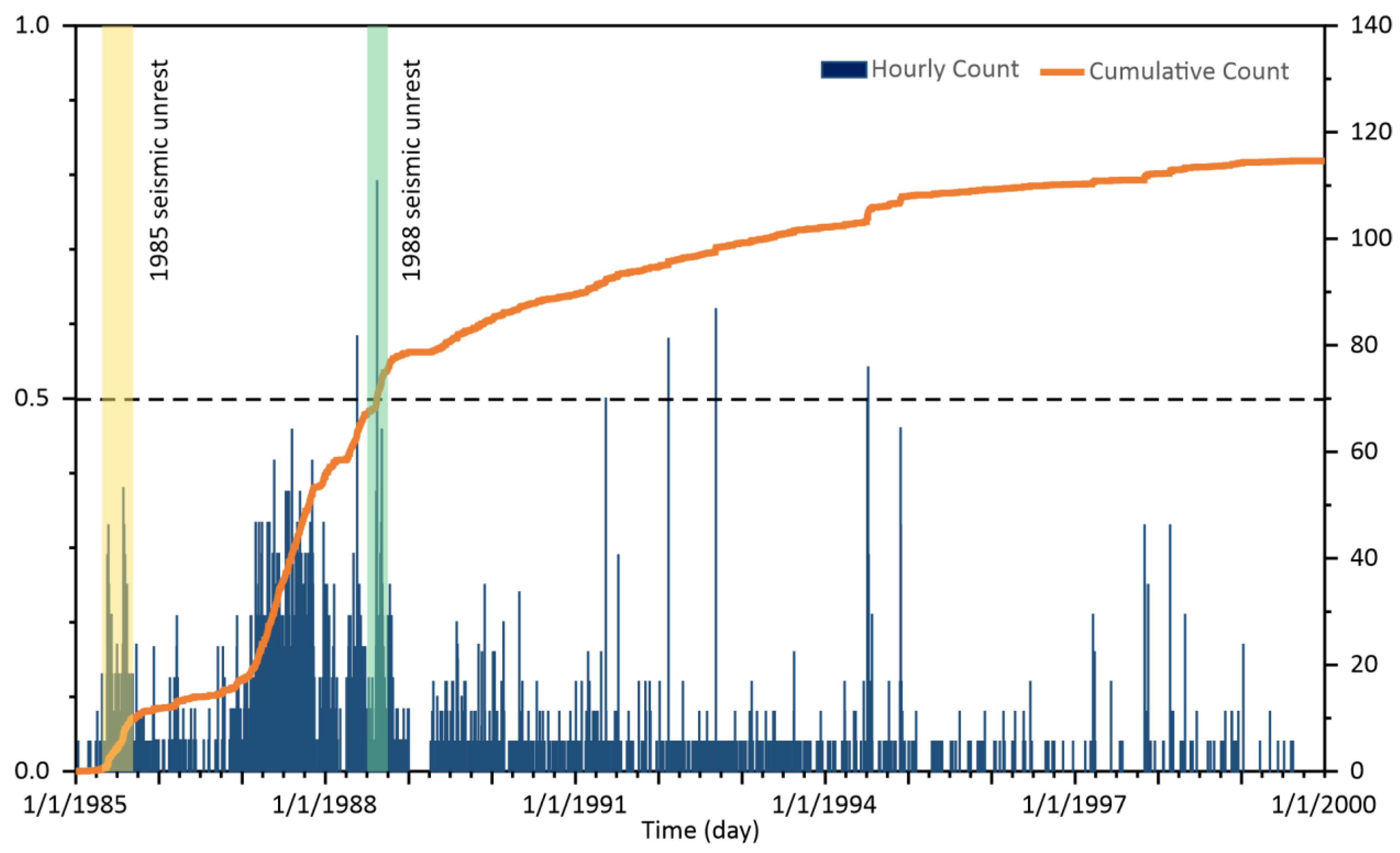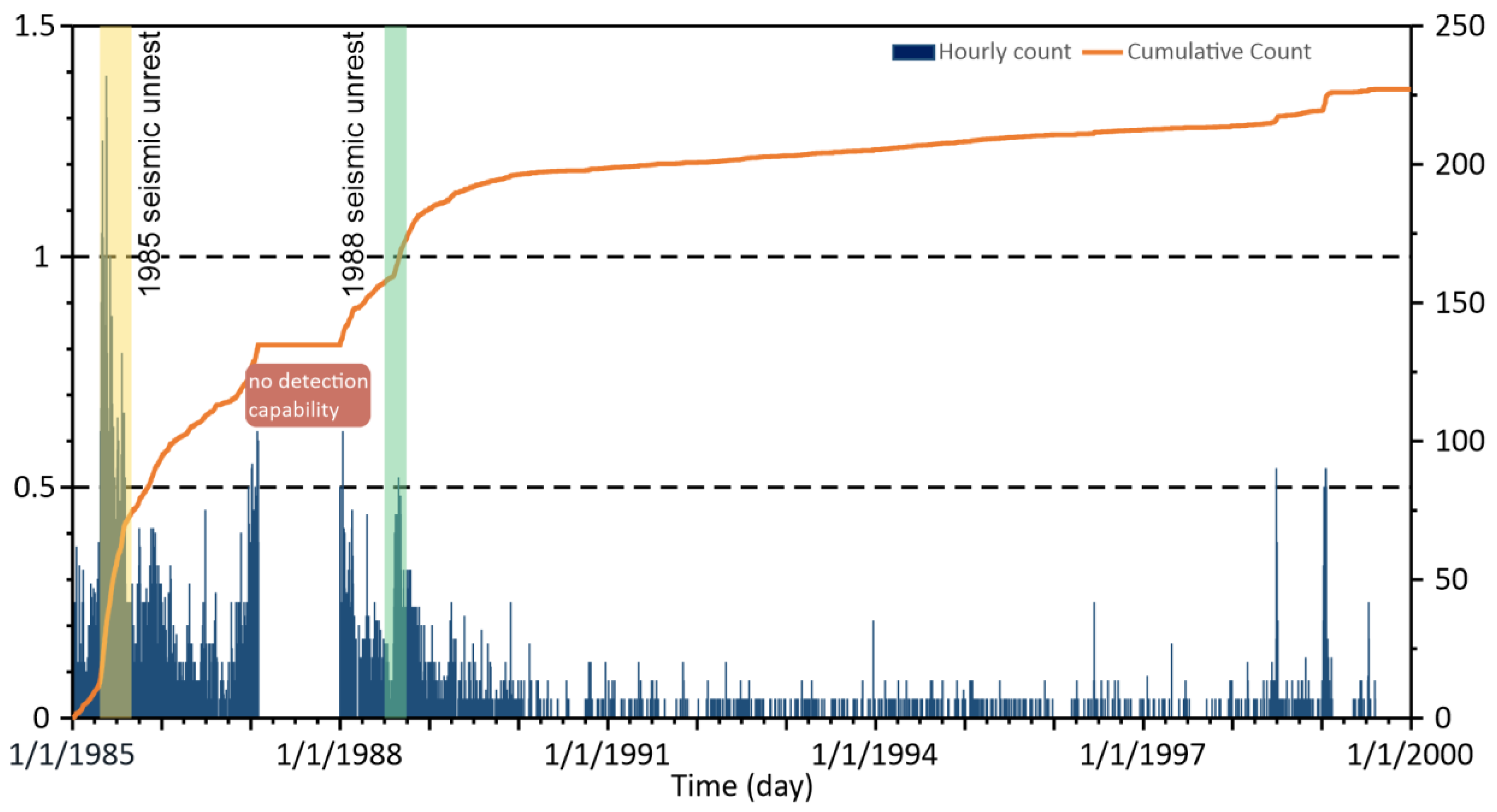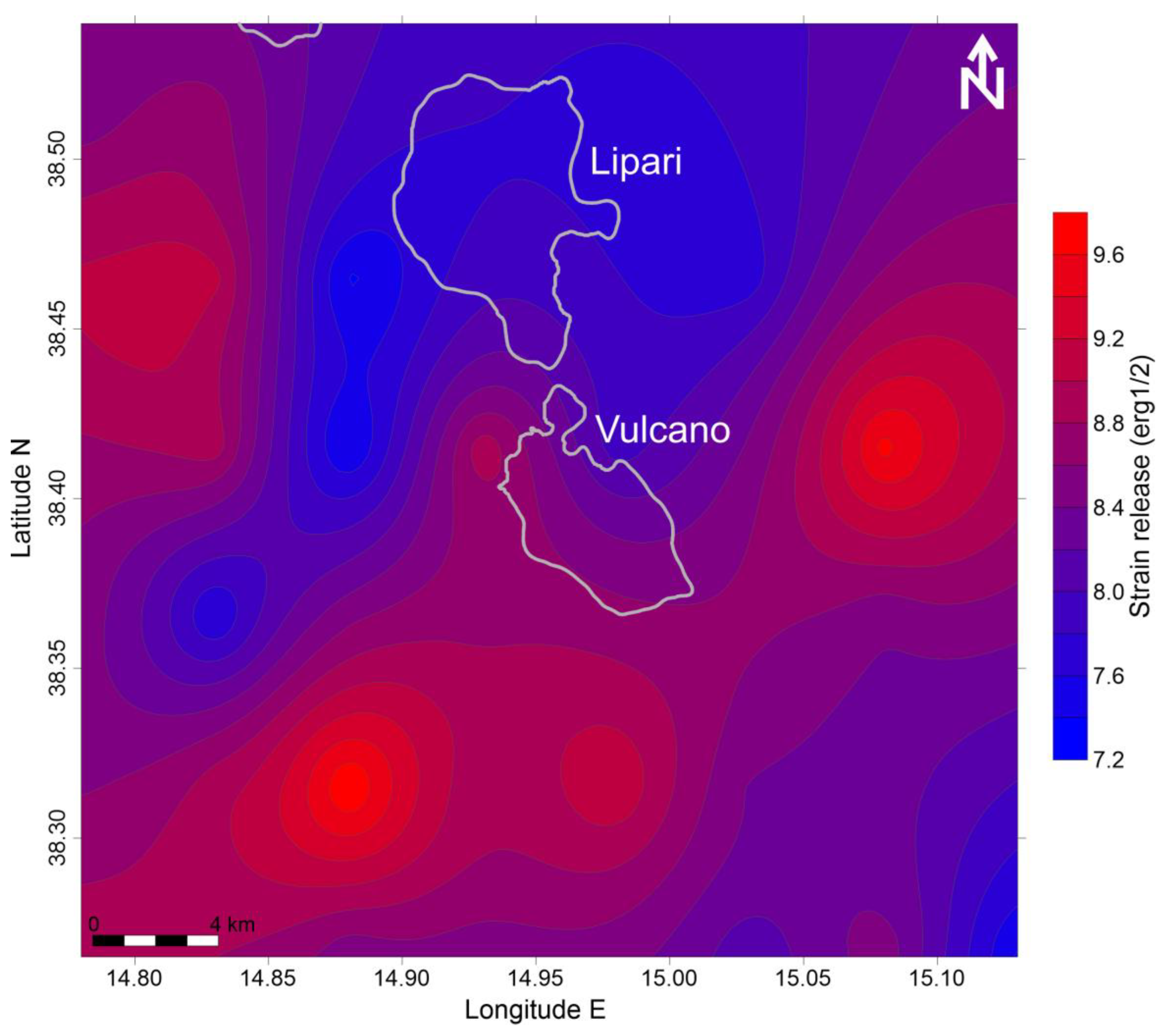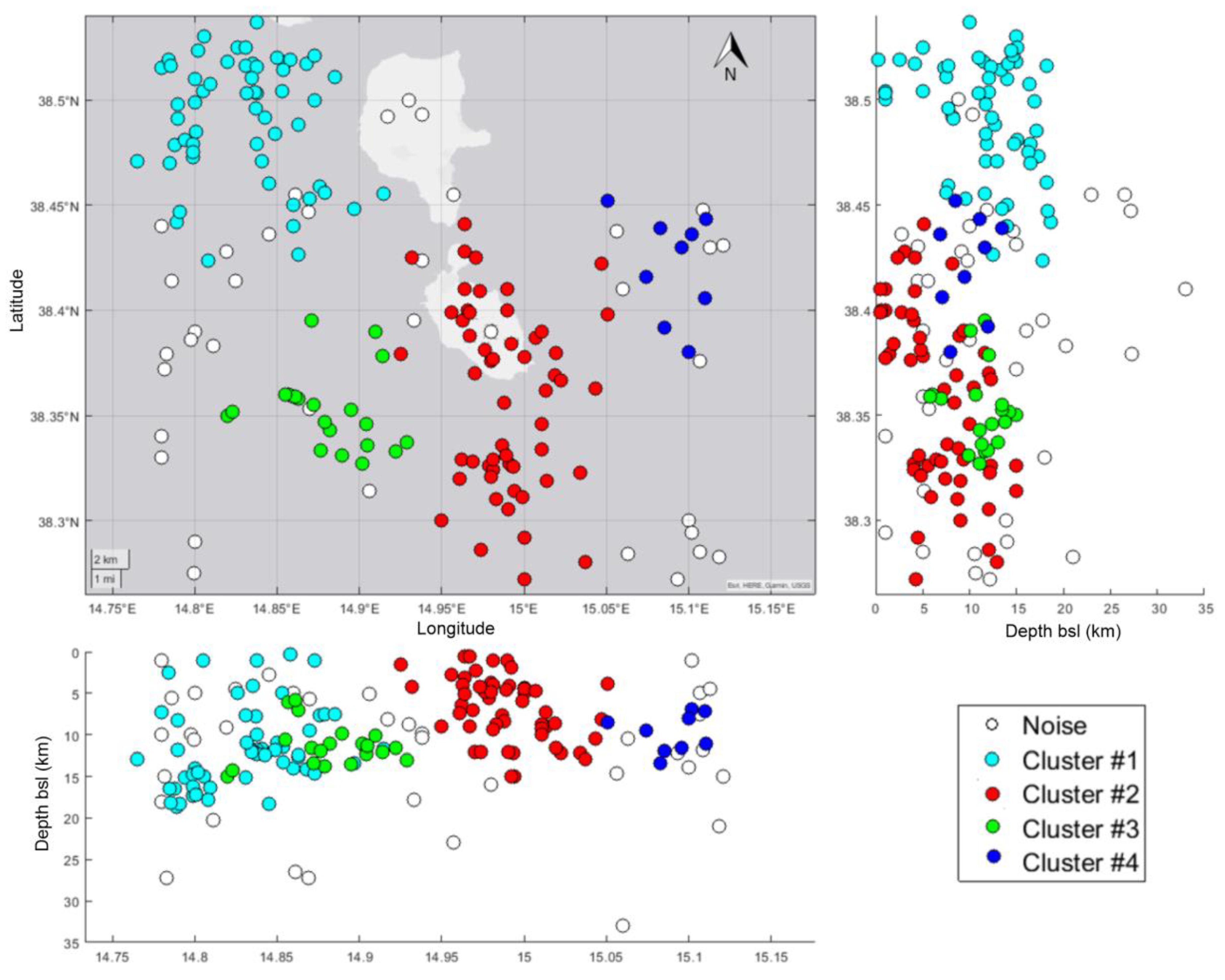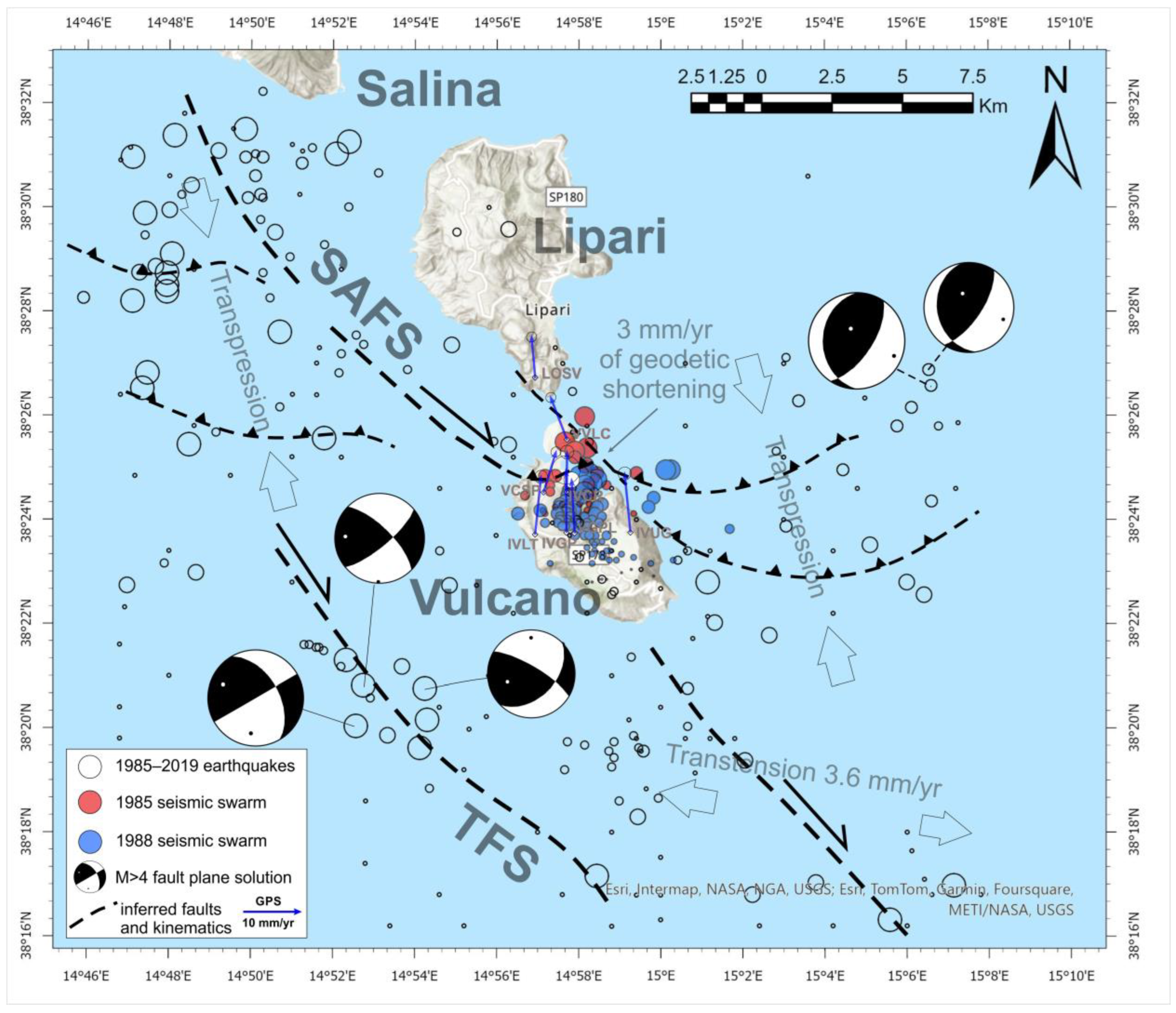1. Introduction
Decades-long measures and observations have proved the paramount importance of geophysical and geochemical monitoring on volcanoes worldwide [
1,
2,
3]. Recent examples are the 125-day lava flows in Kilauea, Hawaii, in 2018 [
4]; the 85-day eruption in La Palma, Canary Islands, in 2021 [
5]; and the 2021–2024 eruptions in Iceland [
6,
7], with their devastating effects and high social impact that made continuous monitoring vital for constraining damage and limiting health problems for local populations. Records of monitoring measurements can highlight even subtle changes in volcanic unrest and save many lives, such as documented by the evacuation of ~20,000 people before the 1991 eruption of Mount Pinatubo in the Philippines [
8]. When eruptive activity is heralded by typical and recurring variations in the monitored parameters, scientists can envisage potential eruptive scenarios, alerting the civil protection and other authorities of impending activity. An example of such timely communications concerns Mount Etna in Italy, where frequent lava fountains (52 in 2021 alone) have led to the design of specific warning systems for similar events (e.g., [
9,
10]).
Vulcano Island in Italy (the third for dimensions in the Aeolian Archipelago) has a long record of geophysical and geochemical measurements, with pioneering work dating back to the 1800s [
11]. Systematic gas samplings, continuous seismic monitoring, and ground deformation measurements started in the 1970s (e.g., [
12,
13,
14]). Since then, a few episodes of volcanic unrest, marked by high fumarole temperatures, changes in gas composition, increased seismic activity and areal dilatation, have occurred without leading to an eruption (see [
15] and the references therein). However, the Vulcanian eruptive style could have potentially disastrous consequences for the local population (~1000 inhabitants) and for the thousands of tourists which come here every year, especially in summer [
16,
17]. The last eruption stemmed from La Fossa Crater (in the northern part of the island;
Figure 1) and spanned from 1888 to 1890, causing phreatomagmatic explosions and pyroclastic flows, which swept the flanks of the crater. Metres-large bread-crust bombs were also ejected with no consequence to people, who were already evacuated. Volcanic activity in this, as in the other six islands of the Aeolian Archipelago (
Figure 1), is a typical expression of a subduction zone, with stratovolcanoes formed by the accumulation, from 400 ky to the present, of lava flows and pyroclastic deposits with calc-alkaline, shoshonitic, and potassic affinity [
18,
19,
20,
21].
The most recent unrest on the island of Vulcano began in September 2021, with anomalous values in geochemical and geophysical parameters mostly returning to background levels by the end of 2022. The anomalous conditions prompted the Italian Civil Protection to issue an alert for inhabitants and tourists, which lasted until December 2023. Federico et al. [
15] provides a comprehensive description of the multidisciplinary data collected by the permanent monitoring networks run by Istituto Nazionale di Geofisica e Vulcanologia (INGV), along with findings from additional temporary measurements. From a seismic viewpoint, two factors were the main features of the unrest: (i) the occurrence of Very-Long-Period events (VLP; with frequency peak ~0.3 Hz and, often, superimposed higher frequency peaks up to 5 Hz) and (ii) a low to moderate (maximum magnitude of ML4.6) tectonic seismicity. The whole picture drawn by the collected geochemical and geophysical parameters highlights the involvement of both magmatic and hydrothermal systems with a high level of unrest [
15,
26,
27]. But how did this situation differ from previous unrest episodes that hit the volcano? Based on past seismic monitoring data, this work aims to provide an answer to this question by putting the changes in seismic activity between 2021 and 2022 into context. Using old reports and institutional datasets from different sources, we provide a reconstruction of the occurrence frequency of seismic events from 1985 to 1999 and the hypocentral location of the most energetic ones (M > 2.5) from 1985 to 2019. We also present a 2D analysis of the strain release in the study area in the considered time span and the application of the DBSCAN code [
28], an unsupervised pattern classification method, which provides further insights into the earthquake data.
Based on the catalogues shared by [
29], our study constitutes an easy-to-use collection of information for decision-making support in case of future seismic unrest conditions on Vulcano.
2. Seismic Data Analysis
From 1985 to 1999, routine analysis of seismic data for surveillance purposes of the Vulcano area and the surrounding region was the task of scientific teams working for the Istituto Internazionale di Vulcanologia (IIV), a department of the Consiglio Nazionale delle Ricerche (CNR). These experts regularly issued information to the Italian Civil Protection. Afterwards, the analysis was conducted by scientific personnel of the INGV.
To identify the main features of seismic activity on and around the island of Vulcano in the 34 years preceding the last volcano unrest, we collected and examined the available seismic data recorded from 1985 to 2019, most of which were in analogue format and/or dispersed in old repositories. Consequently, the data here reported have many sources. The oldest data are from paper documents, namely forms and reports compiled in the 1980s. We also collected information from periodic bulletins, articles and, for recent years, from the INGV national database (
https://terremoti.ingv.it/, accessed on 9 January 2024). A list of the references for the entire collection can be found in [
29].
2.1. Seismic Network
The Aeolian Islands Seismic Network (AISN) was created in the late 1970s and was run by IIV staff. In the middle of the 1980s, AISN encompassed eight stations installed on the islands of Alicudi, Lipari, Vulcano, Stromboli and in Novara di Sicilia (in the northern part of Sicily) (
Figure 1). The stations were originally equipped with short-period (1 s) seismometers; the analogue signal was transmitted to Lipari where it was acquired on paper and (temporarily) stored on magnetic tapes. These two kinds of support were shipped to IIV in Catania weekly for the analysis and playback of signals.
Over the years, the network has undergone several technical upgrades: the installation of new stations; the digitalization of the signal (with sampling frequency of 125 or 100 Hz); direct transmission to the INGV data acquisition centre in Catania (from 2000 onwards); and replacement of the original analogue stations with new digital ones, all equipped with three-component broadband seismometers.
It should be noted that the reuse of the magnetic tapes has led to the loss of past recordings, while most of the seismograms on paper up to the mid-2000s are still available at INGV. Recent raw (digital) seismic data are available in the European Integrated Data Archives (
www.eida.ingv.it, accessed on 22 October 2024).
2.2. Dataset
The region of interest focuses on the island of Vulcano, Italy (
Figure 1). Based on the criteria originally applied for the routine analysis of seismic data for surveillance purposes, we compiled three catalogues (see [
29]) including different types of seismic events based on their magnitude and location, namely the following:
Earthquakes with M > 2.5;
Events in the Lipari–Vulcano complex;
Events in the Fossa Crater.
2.2.1. Earthquakes with M > 2.5
For earthquakes with a magnitude > 2.5, our data collection refers to the following coordinates: latitude from N 38.265° to 38.540°, longitude from E 14.780° to 15.130° (
Figure 1). The time span covered by these data is from 1985 to 2019. For each earthquake, the hypocentral parameters (UTC origin time, latitude in degrees, longitude in degrees, depth in km, azimuthal gap in degrees and location errors in km, when available), duration magnitude (Md) and local magnitude (ML) are reported.
A comparison between ML and Md is proposed in
Supplementary Figure S1. There is a good agreement in the range of magnitude values reported in this catalogue; consequently, we will indicate with M the magnitude of the seismic events discussed in the following.
The hypocentral parameters listed in our catalogue are referred to the INGV database from 2000 to 2019 ([
30] and
https://terremoti.ingv.it/, accessed on 9 January 2024). Location data from previous years were not revised, as the original signals in the 1980s and 1990s were in analogue format; they were recorded on magnetic tape, which was erased to be reused over time. In addition, some digital recordings have been lost due to the deterioration of the CDs used for their storage.
P- and S-wave arrival times of earthquakes were mainly picked on the records of the permanent seismic stations run by IIV until 1999 and by INGV ever since. In the 1980s and 1990s, improved earthquake locations were achieved when the magnitude allowed the acquisition of additional phase data from the local seismic networks in the Calabrian and Peloritan areas, thanks to the collaboration with Professor Ignazio Guerra and Professor Antonio Bottari of Calabria and Messina University, respectively.
The collected hypocentral parameters were calculated by means of the Equivalent Velocity Method [
31] until the 1980s; since then, HYPO71PC [
32] and Hypoellipse 2.0 [
33] computer programmes have been used. The velocity models were those of Jeffreys and Bullen [
34] and Falsaperla et al. [
35]; the latter was obtained using deep seismic sounding data recorded in the Aeolian Islands and was therefore particularly suitable for the location of the seismic events with origin on the island.
From the analysis of the daily number of earthquakes, it is evident that the occurrence rate of earthquakes with M > 2.5 is relatively low (
Figure 2) and can be easily overtaken during a single seismic swarm in other volcanic regions, such as Campi Flegrei at the time of writing [
36]. M4.6 is the maximum magnitude (
Figure 2).
The catalogue encompasses 179 earthquakes (complete with all hypocentral parameters); only 9 of them have M ≥ 3.5 (~5% of the entire sample;
Figure 3a). Most focal depths are within the top 15 km (148 foci, ~83%). Relatively few shallow earthquakes (depth < 10 km) have been recorded since 2000 (
Figure 3b,c); however, we cannot exclude the hypothesis that this evidence may be related to the upgrade of the seismic network for the setup of stations on other islands of the Aeolian Archipelago (
Figure 1).
2.2.2. Seismic Events in the Lipari–Vulcano Complex
This catalogue includes the hourly occurrence frequency of seismic events with an origin within a radius of 10 km around La Fossa Crater (
Figure 1 and
Figure 4). For a description of the various types of local events, we address interested readers to, e.g., [
37,
38,
39,
40]. The source mechanism of these signals can be related to (i) brittle failure of the rocks (clear arrivals of P- and S-waves, short duration, rapid decay) and (ii) fluid dynamics (often emergent onset, unclear seismic phases, and relatively long duration compared to the amplitude).
The events in this catalogue were recorded by at least three stations in the Lipari–Vulcano area in the years from 1985 to 1999. Two main changes in the cumulative number of events mark the 1980s, with the occurrence of two major seismic swarms in 1985 and 1988, respectively (
Figure 4). Duration and epicentral location neatly distinguish these seismic unrests from others that occurred in the 1990s. Unlike the short-lived (generally a few hours) episodes of the 1990s, which appear as peaks in
Figure 4, the duration covered about four months in 1985 (from 25 April to 31 August) and three months in 1988 (from 2 July to 30 September). In addition, their foci were mostly confined to the interior of the island (
Figure 5).
In the catalogue, the 1985 seismic swarm shows 32 locations for seismic events with 1 ≤ M ≤ 2.3 and hypocentres up to 4 km (
Figure 5a–c). The seismicity associated with the 1985 unrest was mostly confined to the northern part of Vulcano, a sector of the island heavily affected by fumaroles and high temperatures. Seismic events with fluid dynamic origins were numerous during the 1985 unrest [
37]; however, Very-Long-Period (VLP) events could not be recorded due to the use of instrumental equipment with short-period (1 s) geophones.
Despite its shorter duration with respect to the 1985 unrest, the swarm in 1988 had seismic events with relatively higher magnitude (1.8 ≤ M ≤ 2.5), but comparable focal depths (<5 km). Also in this case, the epicentral locations (100 events in about three months) were mostly inside the island and roughly outlined a sub-vertical NNW-SSE trend (
Figure 5d,e).
The relevance of the 1985 and 1988 seismic unrests is evident from their duration (several months) and location, with seismogenic sources mostly within the island, where the pressure of fluids of the volcanic system acted. These characteristics distinguish these episodes from other seismic swarms, such as those that occurred in 1994, during which 65 events with 1.2 ≤ M ≤ 4 occurred in July and 24 events with 1.7 ≤ M ≤ 3.6 occurred in November (
Figure 4); apart from their shorter lifespan, they were mainly located offshore of the southwest of the island.
Compared to the past, the duration of the 2021 seismic unrest (~16 months from the beginning to the return to background levels) was much longer than that in 1985 (4 months) and 1988 (3 months). This evidence and the occurrence of numerous VLP events pinpoint the greater relevance of this latest episode.
2.2.3. Seismic Events in the Fossa Crater
The reference station for the counting of these seismic events was named VCR until mid-2004 and IVCR ever since. It is located in the northern flank of the Fossa Crater (with coordinates N38.41°, E14.96°), close to a large fumarole field (
Figure 1).
Hourly frequency and cumulative counts of seismic events at the reference station (IVCR) from 1985 to 1999 are reported in
Figure 6. These events are mostly microshocks with short duration (less than a few tens of seconds) and low energy release (<10
13 ergs; [
38]) linked to fluid dynamics in the shallow hydrothermal system. The count required the event to exceed an amplitude threshold (20 mm) on the paper drum recordings at the reference station. There was no distinction among the events, as their frequency content varied from 0 to 30 Hz and encompassed various types of signals, from Long-Period (LP) to volcano–tectonic events (e.g., [
37]).
The hourly frequency of seismic events recorded at the IVCR station during the 1985 seismic swarm reached a maximum of 1.39 across the entire dataset and was also more than double that in the 1988 episode (
Figure 6). The low values (generally < 3 events/day) of the hourly frequency in the 1990s were only punctuated by short-lived increases with the same maximum value (0.54) on 28 June 1998 and on 15 and 17 January 1999.
3. 2D Strain Release Map and DBSCAN Application
A validation of our catalogue regarding the 1985 and 1988 seismic unrests can be found in multidisciplinary studies, which discuss strong concurrent changes in other geophysical and geochemical parameters. Here, we cite two examples. During the 1985 unrest, the radial component of a local tilt borehole station measured progressive inflation at the La Fossa Crater; the trend reversed with the decline of the seismic swarm [
41]. Chiodini et al. [
42] observed a strict temporal relationship between chemical and isotopic changes in fumarolic fluids and local microseismic activity in 1988; they surmised that increased fluid pressure at depth could be a common source of such variations.
Regarding the catalogue of earthquakes with M > 2.5, the paucity of the number of stations along with the geometry of the seismic network make the magnitude threshold set in the 1980s for surveillance purposes reliable. For the part of the earthquake catalogue prior to the 1990s, most information concerning root mean square (rms) values and errors is either missing or vague. Available rms values of the earthquakes from 1991 to 2019 are of 0.21 s on average. The qualitative and quantitative improvement of the data (with the use of broadband stations) allowed for a substantial decrease in the horizontal and vertical error, which did not exceed 3.2 km in the years from 2000 to 2019. Conversely, the azimuthal gap remained relatively high due to the objective difficulty of locating small earthquakes that are not detectable by distant stations.
To evaluate the overall robustness of hypocentral locations, in the following we propose a 2D map of strain release in the study area and the application of an unsupervised method of pattern recognition.
Our strain release calculation is obtained from the value of the square root of the energy, using the magnitude–energy relationship computed for Italian earthquakes by Di Filippo and Marcelli [
43].
Figure 7 depicts a 2D map of the strain release of earthquakes with M > 2.5 from 1985 to 2019. The average value was calculated within a regular grid of 0.05° in latitude and longitude in the study area and is reported in logarithmic scale. The strain release values reach peaks in specific sectors, which highlight some seismogenic regions near the island of Vulcano (
Figure 7). Specifically, relatively high values are reached NW, SW and E offshore of the island (
Figure 7).
The application of pattern recognition to the earthquakes with M > 2.5 from 1985 to 2019 provides similar evidence using a technique of unsupervised learning, namely without human supervision (
Figure 8). There are several unsupervised classification strategies, each with its own pros and cons (e.g., [
44]). The chosen technique is DBSCAN (Density-Based Spatial Clustering of Applications with Noise; see [
28];
www.yarpiz.com, accessed on 24 February 2025). A (freely downloadable) version of the DBSCAN classifier running in MATLB can be found in Heris [
45]. A big advantage of DBSCAN with respect to other pattern recognition techniques, such as K-Means, is that it can find clusters of arbitrary shapes. Therefore, there is no assumption of spherical clusters, which can be unrealistic especially in volcanic environments. In our application of DBSCAN, we consider a unit volume and calculate the density of earthquakes inside this volume. Input parameters were latitude, longitude, depth and magnitude. The technique does not require the number of desired clusters as an input. All points at the margins of a cluster and that cannot be density reached are identified as noise points (see empty dots in
Figure 8).
Figure 8 highlights four main clusters with different colours, located to the NW (light blue), SW (green) and E (blue) of Vulcano along with a fourth cluster (red) in the NNW-SSE direction from the northern part of the island to the southern margin of the study area.
Overall, our results from the 2D strain release map and DBSCAN application offer a robust indication of the validity of the dataset and can serve as a baseline for future comparative analyses.
4. Discussion
Independent findings from Fault Plane Solutions (FPSs) and structural data provide further support to the validity of our dataset.
Figure 9 depicts the FPS of the earthquakes in the study period derived from references [
46,
47,
48] (a numbered list can be found in
Supplementary Table S1). The presence of distinct seismogenic source volumes is confirmed by FPSs, which highlight right-lateral transpressive motions on nodal planes trending NW–SE and WNW–ESE to the west of Lipari Island and inverse kinematics on NE–SW-oriented nodal planes to the east. Right-lateral transtensional kinematics instead characterize seismic events SW of Vulcano Island.
From the structural viewpoint, the sector of the Aeolian Archipelago where the Lipari–Vulcano complex lies is mainly made up of overlapping én-echelon fault segments trending NNW-SSE, with oblique (right-lateral) transtensional kinematics, belonging to the so-called Tindari Fault System (TFS in
Figure 10; see [
22,
23,
49,
50]). The GPS velocity field in the Lipari–Vulcano complex also reveals that a geodetic contraction of about 3 mm/yr occurs between the two islands (see [
42] and
Figure 10). This geodetic shortening along with the transpressional to almost-pure compressive kinematics of some FPSs of earthquakes located NW of the Lipari–Vulcano complex (
Figure 9) imply a recent positive tectonic inversion along a NW-SE-oriented tectonic lineament, the Sisifo–Alicudi Fault System (SAFS in
Figure 10, see [
22]). Consequently, the Lipari–Vulcano complex currently appears deformed by transpression on its northern sector, which affects Lipari and the northern part of the island of Vulcano (Vulcanello area), while transtension still persists southwards between Vulcano and the Gulf of Patti (
Figure 1; [
23,
24]). Transpressional regimes may have implications for fluid circulation, providing an engine for increased pore pressure in the crustal domain underneath the volcanic complex. Such an increased pore pressure may cause volcanic unrest, with fluids rising to the surface where transtensional kinematics still persist, as on Vulcano island. In addition, over-pressured hydrothermal fluids can trigger earthquakes in the area by reducing friction along fault planes.
Complex interactions between fluids and fracturing are a common problem in volcanic and hydrothermal regions, where the increase in fluid pressure can lead to burst-like swarms ([
36] and references therein).
In a broader view, our findings reveal that hazards in volcanic systems located in active geodynamic domains should also be assessed considering tectonic discontinuities, which can act as either barriers or preferential paths for fluid circulation. Furthermore, faults instability in active volcanic contexts can indicate precursory signals of potential unrest phases when fluid over-pressure drives faults to rupture. In this view, seismic monitoring at Vulcano has a potential application in early warning strategies.
5. Conclusions
The collection of old datasets provides context to new data. Our reconstruction of seismic activity from continuous monitoring over the last 34 years aimed to enable all potential users (i) to have rapid accessibility to useful, but hitherto scattered, information and (ii) to accelerate assessment and action in case of future volcano unrest.
Our catalogues also collect data, such as the number of seismic events and hypocentral parameters of earthquakes, taken from old original reports. We have integrated this information with the calculation of the seismic strain release related to those events. As a further integration, the examined dataset contains files with the occurrence rate, hypocentral location, magnitude and strain release of the seismic events, which were located during the important seismic unrests of 1985 and 1988. In our opinion, this is valuable information to compare and highlight seismogenic zones activated during distinct unrests and offers an easy-to-use reference in case of future, sudden seismic changes to interpret. The pressing research questions on seismic hazard and risk require data acquisition over long periods of time and powerful tools for multivariate data analysis. Our results provide an example of a possible application of pattern recognition to earthquakes in the area of Vulcano, contributing to the identification of seismic hazard zones. Machine learning techniques are very promising in this regard and can be envisaged as a fundamental support for decision-makers in this as well as other related aspects of risk management.
Supplementary Materials
The following supporting information can be downloaded at
https://www.mdpi.com/article/10.3390/geosciences15030096/s1. Figure S1: Comparison between ML and Md for the earthquakes recorded from 1985 to 2019. The dotted line marks the linear regression obtained. Table S1: Date, origin time, duration magnitude, local magnitude and reference for each Fault Plane Solution in
Figure 9. The first column contains the sequential number reported in the figure. References are those used in the main article.
Author Contributions
S.F. conceived this study, applied pattern recognition and wrote the paper; S.F. and S.S. conducted the data collection; S.F., S.S. and O.C. performed the seismic data analysis and prepared the figures; G.B. analyzed structural data; all the authors contributed to the discussion and revision of data. All authors have read and agreed to the published version of the manuscript.
Funding
This research was undertaken within the project WUnderVul (Toward a Wider Understanding of Vulcano—WUnderVul). WUnderVul belongs to the Progetti Dipartimentali INGV and is funded by the Ministero dell’Università e della Ricerca; funding number 1020.010.
Data Availability Statement
The catalogues presented in this study are available in the DataRep INGV—Osservatorio Etneo OPENDATA Repository at [
https://doi.org/10.13127/VULCANO/SEISMICITY_1985-2019, last access on 6 March 2025]. The data repository chosen allows public access to data without barriers. Raw (digital) seismic data are available in the European Integrated Data Archives (
www.eida.ingv.it, accessed on 22 October 2024). The hypocentral parameters listed in our catalogue refer to the INGV database from 2000 to 2019 (
https://terremoti.ingv.it/, accessed on 9 January 2024, and Alparone et al. [
30]). A list of the references for the entire collection can be found in the Bibliography_of_the_data_sources.pdf file, which is an integral part of the dataset shared by Falsaperla et al. [
29]. A (freely downloadable) version of the DBSCAN classifier running in MATLB can be found in Heris [
45].
Acknowledgments
We are grateful to Graziella Barberi for her support in compiling some hypocentral parameters of the earthquakes, and to Antonino Sicali and Horst Langer for their valuable help with the graphical software. Numerous researchers and technicians have contributed to the acquisition and analysis of seismic data at IIV and INGV. We gratefully acknowledge their commitment, which made this work possible.
Conflicts of Interest
The authors declare no conflicts of interest.
References
- Newhall, C.G.; Costa, F.; Ratdomopurbo, A.; Venezky, D.Y.; Widiwijayanti, C.; Win, N.T.Z.; Tan, K.; Fajiculay, E. WOVOdat—An online, growing library of worldwide volcanic unrest. J. Volcanol. Geotherm. Res. 2017, 345, 184–199. [Google Scholar] [CrossRef]
- Bossu, R.; Haslinger, F.; Hébert, H. History and activities of the European-Mediterranean Seismological Centre. Seismica 2024. [Google Scholar] [CrossRef]
- Global Volcanism Program. [Database] Volcanoes of the World (v. 5.2.6; 5 February 2025). Distributed by Smithsonian Institution, Compiled by Venzke, E. 2025. Available online: https://doi.org/10.5479/si.GVP.VOTW5-2024.5.2 (accessed on 21 February 2025).
- Patrick, M.R.; Houghton, B.F.; Anderson, K.R.; Poland, M.P.; Montgomery-Brown, E.; Johanson, I.; Thelen, W.; Elias, T. The cascading origin of the 2018 Kīlauea eruption and implications for future forecasting. Nat. Commun. 2020, 11, 5646. [Google Scholar] [CrossRef]
- Carracedo, J.C.; Troll, V.R.; Day, J.M.D.; Geiger, H.; Aulinas, M.; Soler, V.; Deegan, F.M.; Perez-Torrado, F.J.; Gisbert, G.; Gazel, E.; et al. The 2021 eruption of the Cumbre Vieja volcanic ridge on La Palma, Canary Islands. Geol. Today 2022, 38(3), 94–107. [Google Scholar] [CrossRef]
- Einarsson, P.; Brandsdóttir, B. Seismicity of the Northern Volcanic Zone of Iceland. Front. Earth Sci. 2021, 9, 628967. [Google Scholar] [CrossRef]
- Parks, M.M.; Sigmundsson, F.; Drouin, V.; Hreinsdóttir, S.; Hooper, A.; Yang, Y.; Ófeigsson, B.G.; Sturkell, E.; Hjartardóttir, Á.R.; Grapenthin, R.; et al. 2021–2023 unrest and geodetic observations at Askja volcano, Iceland. Geophys. Res. Lett. 2024, 51, e2023GL106730. [Google Scholar] [CrossRef]
- Harlow, D.H.; Power, J.A.; Laguerta, E.P.; Ambubuyog, G.; White, R.A.; Hoblitt, R.P. Precursory seismicity and forecasting of the June 15, 1991, eruption of Mount Pinatubo. In Fire and Mud: Eruptions and Lahars of Mount Pinatubo, Philippines; University of Washington Press: Seattle, WA, USA; PHIVOLCS: Quezon City, Philippines, 1996; pp. 223–247. [Google Scholar]
- D’Agostino, M.; Di Grazia, G.; Ferrari, F.; Langer, H.; Messina, A.; Reitano, D.; Spampinato, S. Volcano monitoring and early warning on Mt. Etna, Sicily based on volcanic tremor: Methods and technical aspects. In Complex Monitoring of Volcanic Activity Methods and Results; Zobin, V., Ed.; Nova Science Publishers, Inc.: Hauppauge, NY, USA, 2013; pp. 53–92. [Google Scholar]
- Cannavò, F.; Cannata, A.; Cassisi, C.; Di Grazia, G.; Montalto, P.; Prestifilippo, M.; Privitera, E.; Coltelli, M.; Gambino, S. A multivariate probabilistic graphical model for real-time volcano monitoring on Mount Etna. J. Geophys. Res. 2017, 122(5), 3480–3496. [Google Scholar] [CrossRef]
- Mercalli, G.; Silvestri, O. Le eruzioni dell’isola di Vulcano, incominciate il 3 Agosto 1888 e terminate il 22 Marzo 1890. Ann. Dell’ufficio Cent. Meteorol. E Geodin. Ital. 1891, 10(4), 1–213. [Google Scholar]
- Latter, J.H. Near Surface Seismicity of Vulcano, Aeolian Islands, Sicily. Bull. Volcanol. 1971, 35, 117–126. [Google Scholar] [CrossRef]
- Carapezza, M.; Nuccio, P.M.; Valenza, M. Genesis and evolution of the fumaroles of Vulcano (Aeolian Islands, Italy): A geochemical model. Bull. Volcanol. 1981, 44(3), 521–525. [Google Scholar] [CrossRef]
- Frazzetta, G.; Lanzafame, G.; Villari, L. Deformazioni e tettonica attiva a Lipari e Vulcano (Eolie). Mem. Soc. Geol. It. 1982, 24, 293–297. [Google Scholar]
- Federico, C.; Cocina, O.; Gambino, S.; Paonita, A.; Branca, S.; Coltelli, M.; Italiano, F.; Bruno, V.; Caltabiano, T.; Camarda, M.; et al. Inferences on the 2021 ongoing volcanic unrest at Vulcano Island (Italy) through a comprehensive multidisciplinary surveillance network. Remote Sens. 2023, 15, 1405. [Google Scholar] [CrossRef]
- Barbano, M.S.; Castelli, V.; Pirrotta, C. Materiali per un catalogo di eruzioni di Vulcano e di terremoti delle isole Eolie e della Sicilia nordorientale (secc. XV–XIX). In Quaderni di Geofisica; Istituto Nazionale di Geofisica e Vulcanologia (INGV): Roma, Italy, 2017; Volume 143, ISSN 1590-2595. [Google Scholar]
- Selva, J.; Bonadonna, C.; Branca, S.; De Astis, G.; Gambino, S.; Paonita, A.; Pistolesi, M.; Ricci, T.; Sulpizio, R.; Tibaldi, A.; et al. Multiple hazards and paths to eruptions: A review of the volcanic system of Vulcano (Aeolian Islands, Italy). Earth-Sci. Rev. 2020, 207, 103186. [Google Scholar] [CrossRef]
- Gillot, P.Y. Histoire vulcanique des iles Eoliennes; arc insulaire ou complexe orogenique anulaire? Doc. Trav. IGAL 1987, 14, 35–42. [Google Scholar]
- Gioncada, A.; Mazzuoli, R.; Bisson, M.; Pareschi, M.T. Petrology of volcanic products younger than 42 ka on the Lipari–Vulcano complex (Aeolian Islands, Italy): An example of volcanism controlled by tectonics. J. Volcanol. Geoth. Res. 2003, 122, 191–220. [Google Scholar] [CrossRef]
- Peccerillo, A. The Aeolian arc. In Plio-Quaternary Volcanism in Italy, Petrology, Geochemistry, Geodynamics, 1st ed; Peccerillo, A., Ed.; Springer: Berlin/Heidelberg, Germany, 2005; pp. 173–213. [Google Scholar]
- De Astis, G.; Lucchi, F.; Dellino, P.; La Volpe, L.; Tranne, C.A.; Frezzotti, M.L.; Peccerillo, A. Geology, volcanic history and petrology of Vulcano (central AeolianArchipelago). In The Aeolian Islands Volcanoes; Lucchi, F., Peccerillo, A., Keller, J., Tranne, C.A., Rossi, P.L., Eds.; Geological Society London: London, UK, 2013; Volume 37, pp. 281–348. [Google Scholar]
- Barreca, G.; Bruno, V.; Cultrera, F.; Mattia, M.; Monaco, C.; Scarfì, L. New insights in the geodynamics of the Lipari–Vulcano area (Aeolian Archipelago, southern Italy) from geological, geodetic and seismological data. J. Geodyn. 2014, 82, 150–167. [Google Scholar] [CrossRef]
- Cultrera, F.; Barreca, G.; Ferranti, L.; Monaco, C.; Pepe, F.; Passaro, S.; Barberi, G.; Bruno, V.; Mattia, M.; Musumeci, C.; et al. Structural architecture and active deformation pattern in the northern sector of the Aeolian-Tindari-Letojanni fault system (SE Tyrrhenian Sea-NE Sicily) from integrated analysis of field, marine geophysical, seismological and geodetic data. Ital. J. Geosci. 2017, 136, 399–417. [Google Scholar] [CrossRef]
- Cultrera, F.; Barreca, G.; Burrato, P.; Ferranti, L.; Monaco, C.; Passaro, S.; Pepe, F.; Scarfì, L. Active faulting and continental slope instability in the Gulf of Patti (Tyrrhenian side of NE Sicily, Italy): A feld, marine and seismological joint analysis. Nat. Hazards 2017, 86, S253–S272. [Google Scholar] [CrossRef]
- Tarquini, S.; Isola, I.; Favalli, M.; Battistini, A.; Dotta, G. TINITALY, a Digital Elevation Model of Italy with a 10 Meters Cell Size (Version 1.1); Istituto Nazionale di Geofisica e Vulcanologia (INGV): Rome, Italy, 2023. [Google Scholar] [CrossRef]
- Aiuppa, A.; Bitetto, M.; Calabrese, S.; Delle Donne, D.; Lages, J.; La Monica, F.P.; Chiodini, G.; Tamburello, G.; Cotterill, A.; Fulignati, P.; et al. Mafic magma feeds degassing unrest at Vulcano Island, Italy. Commun. Earth Environ. 2022, 3, 255. [Google Scholar] [CrossRef]
- Giuffrida, M.; Salerno, G.; Viccaro, M. Multiple magma recharges over prolonged period ultimately trigger eruptions at Vulcano, Aeolian Islands. Sci. Rep. 2025, 15, 1260. [Google Scholar] [CrossRef]
- Hochspringen, M.E.; Kriegel, H.P.; Sander, J.; Xu, X. A density-based algorithm for discovering clusters in large spatial databases with noise. In Proceedings of the Second International Conference on Knowledge Discovery and Data Mining (KDD-96), Portland, OR, USA, 2–4 August 1996; Simoudis, E., Han, J., Fayyad, U.M., Eds.; AAAI Press: Washington, DC, USA, 1996; pp. 226–231, ISBN 1-57735-004-9. [Google Scholar]
- Falsaperla, S.; Spampinato, S.; Cocina, O. Catalog of the Seismic Activity in and Around the Island of Vulcano, Italy, Between 1985 and 2019 (Version 1); Istituto Nazionale di Geofisica e Vulcanologia (INGV): Rome, Italy, 2023. [Google Scholar] [CrossRef]
- Alparone, S.; Barberi, G.; D’Amico, S.; Di Grazia, G.; Giampiccolo, E.; Maiolino, V.; Mostaccio, A.; Musumeci, C.; Scaltrito, A.; Scarfì, L.; et al. Aeolian Seismic Catalog 2000–2019 (AeolianSC_2000_2019) (Version 1); Istituto Nazionale di Geofisica e Vulcanologia (INGV): Rome, Italy, 2023. [Google Scholar] [CrossRef]
- Caccamo, D.; Neri, G. A new analytic procedure to determine hypocentral parameters of local seismic events. Bull. Seismol. Soc. Am. 1984, 74, 655–667. [Google Scholar] [CrossRef]
- Lee, W.H.; Lahr, J.C. HYPO71PC (Revised): A Computer Program for Determining Hypocenter, Magnitude and First-Motion Pattern of Local Earthquakes; US Geological Survey: Reston, VA, USA, 1975; Open-file Rep: 75-311. [Google Scholar]
- Lahr, J.C. HYPOELLIPSE, Version 2.0. a Computer Program for Determining Local Earthquake Hypocentral Parameters, Magnitude, and First Motion Pattern. US Geological Survey: Reston, VA, USA, 1989.
- Jeffreys, H.; Bullen, K.E. Seismological Tables; Office of the British Association: London, UK, 1958. [Google Scholar]
- Falsaperla, S.; Neri, G.; Velardita, S. Struttura della crosta superiore dell’area delle isole Eolie. Rend. Osserv. Geofis. Reggino 1985, XXIX, 103–111. [Google Scholar]
- Giudicepietro, F.; Avino, R.; Bellucci Sessa, E.; Bevilacqua, A.; Bonano, M.; Caliro, S.; Casu, F.; De Cesare, W.; De Luca, C.; De Martino, P.; et al. Burst-like swarms in the Campi Flegrei caldera accelerating unrest from 2021 to 2024. Nat. Commun. 2025, 16, 1548. [Google Scholar] [CrossRef]
- Falsaperla, S.; Neri, G. Seismic monitoring of volcanoes: Vulcano (southern Italy). Period. Mineral. 1986, 55, 143–152. [Google Scholar]
- Montalto, A. Seismic signals in geothermal areas of active volcanism: A case study from “La Fossa”, Vulcano (Italy). Bull. Volcanol. 1994, 56, 220–227. [Google Scholar] [CrossRef]
- Alparone, S.; Cannata, A.; Gambino, S.; Gresta, S.; Milluzzo, V.; Montalto, P. Time-Space Variation of Volcano-Seismic Events at La Fossa (Vulcano, Aeolian Islands, Italy): New Insights into Seismic Sources in a Hydrothermal System. Bull. Volcanol. 2010, 72, 803–816. [Google Scholar] [CrossRef]
- Cannata, A.; Diliberto, I.S.; Alparone, S.; Gambino, S.; Gresta, S.; Liotta, M.; Madonia, P.; Milluzzo, V.; Aliotta, M.; Montalto, P. Multiparametric Approach in Investigating Volcano-Hydrothermal Systems: The Case Study of Vulcano (Aeolian Islands, Italy). Pure Appl. Geophys. 2012, 169, 167–182. [Google Scholar] [CrossRef]
- Falsaperla, S.; Frazzetta, G.; Neri, G.; Nunnari, G.; Velardita, R.; Villari, L. Volcano Monitoring in the Aeolian Islands (Southern Tyrrhenian Sea): The Lipari-Vulcano Eruptive Complex. In Volcanic Hazards Assessment and Monitoring; Latter, J.H., Ed.; Springer: Berlin/Heidelberg, Germany, 1989; pp. 339–356. [Google Scholar]
- Chiodini, G.; Cioni, R.; Marini, L.; Panichi, C. Origin of the Fumarolic Fluids of Vulcano Island, Italy and Implications for Volcanic Surveillance. Bull. Volcanol. 1995, 57, 99–110. [Google Scholar] [CrossRef]
- Di Filippo, D.; Marcelli, L. Magnitudo ed energia dei terremoti in Italia. Ann. Geophys. 1950, 3, 337–348. [Google Scholar] [CrossRef]
- Naeem, S.; Ali, A.; Anam, S.; Ahmed, M. An Unsupervised Machine Learning Algorithms: Comprehensive Review. IJCDS J. 2023, 13, 911–921. [Google Scholar] [CrossRef]
- Heris, M.K. Source Code for DBSCAN Clustering in MATLAB, Yarpiz. 2015. Available online: https://yarpiz.com/255/ypml110-dbscan-clustering (accessed on 24 February 2025).
- Neri, G.; Barberi, G.; Oliva, G.; Orecchio, B. Spatial variations of seismogenic stress orientations in Sicily, south Italy. Phys. Earth Planet. Inter. 2005, 148, 175–191. [Google Scholar] [CrossRef]
- Scarfì, L.; Messina, A.; Cassisi, C. Sicily and Southern Calabria focal mechanism database: A valuable tool for the local and regional stress-field determination. Ann. Geophys. 2013, 56, D0109. [Google Scholar]
- Scarfì, L.; Barberi, G.; Musumeci, C.; Patanè, D. Seismotectonics of Northeastern Sicily and Southern Calabria (Italy): New constraints on the tectonic structures featuring in a crucial sector for the Central Mediterranean geodynamics. Tectonics 2016, 35, 812–830. [Google Scholar] [CrossRef]
- Lanzafame, G.; Bousquet, J.C. The Maltese escarpment and its extension from Mt. Etna to the Aeolian Islands (Sicily): Importance and evolution of a lithosphere discontinuity. Acta Vulcanol. 1997, 9, 113–120. [Google Scholar]
- Billi, A.; Barberi, G.; Faccenna, C.; Neri, G.; Pepe, F.; Sulli, A. Tectonics and seismicity of the Tindari Fault System, southern Italy: Crustal deformations at the transition between ongoing contractional and extensional domains located above the edge of a subducting slab. Tectonics 2006, 25, TC2006. [Google Scholar] [CrossRef]
| Disclaimer/Publisher’s Note: The statements, opinions and data contained in all publications are solely those of the individual author(s) and contributor(s) and not of MDPI and/or the editor(s). MDPI and/or the editor(s) disclaim responsibility for any injury to people or property resulting from any ideas, methods, instructions or products referred to in the content. |
© 2025 by the authors. Licensee MDPI, Basel, Switzerland. This article is an open access article distributed under the terms and conditions of the Creative Commons Attribution (CC BY) license (https://creativecommons.org/licenses/by/4.0/).
